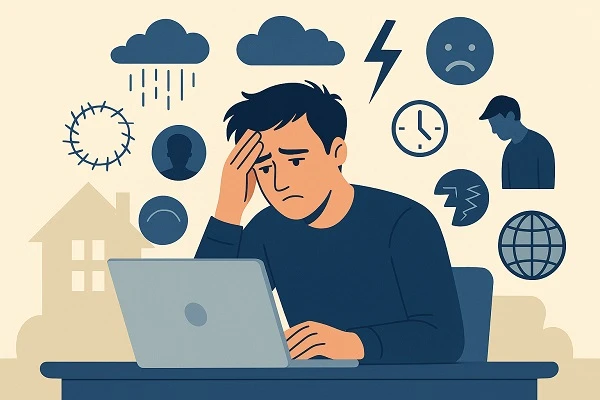Last Updated: July 2, 2025
The Silent Strain: How Remote Work is Fueling a Global Mental Health Crisis

As remote work continues to be a dominant model in today's workforce, its impact on mental health is becoming a growing concern. What began as a temporary adjustment due to global events has now become a long-term trend. While remote work offers flexibility and convenience, it has also introduced new challenges, particularly in the realm of mental health. As we delve into this issue, we will explore global trends in mental health, how remote work has contributed to a surge in conditions like anxiety and depression, and the steps that both individuals and organizations can take to address these issues.
The Rise of Mental Health Issues in Remote Work
The transition to remote work has not been without its drawbacks. A significant rise in mental health issues such as anxiety, depression, and stress has been reported globally. According to a World Health Organization (WHO) report, the pandemic and subsequent rise in remote work have contributed to a dramatic increase in mental health challenges worldwide. In 2020, depression and anxiety cases surged by over 25%, and even as the pandemic has slowed, the mental health impact of prolonged remote work remains significant.
Global Statistics on Mental Health
Various countries have seen notable increases in mental health issues due to remote work. For example, the United States reported a significant rise in depression rates, with a study showing a 27% increase in depression diagnoses from 2019 to 2021. In Germany, mental health concerns rose particularly in younger workers, with a 40% increase in anxiety and depression among remote workers, as reported by the German Psychological Society.
Other regions are also seeing similar trends. In the United Kingdom, a UK government survey revealed that one in five remote workers reported feeling isolated and disconnected, leading to a decline in overall mental well-being. Countries like Australia and Canada have also seen a rise in cases of stress and burnout among remote workers, with many organizations reporting an increase in absenteeism due to mental health reasons.
The Social Isolation Factor
One of the key contributors to the mental health crisis in remote work is social isolation. Unlike traditional office settings, remote work often means employees are cut off from direct human interaction. The lack of face-to-face communication with colleagues and managers has left many workers feeling disconnected. According to a McKinsey & Company study, over 50% of remote workers report feeling lonely or disconnected, which has contributed to increased rates of anxiety and depression.
Loneliness can be particularly exacerbated by the blurring of work-life boundaries. Many remote workers struggle with "always-on" expectations, leading to longer hours, burnout, and diminished social interaction. This is particularly true in industries that were traditionally office-based but have now shifted to remote models.
Solutions to Mitigate the Mental Health Crisis in Remote Work
While the challenges are clear, several solutions have been proposed to help mitigate the mental health crisis associated with remote work. These solutions not only address the root causes of the issues but also focus on creating healthier work environments for remote employees.
Flexible Work Policies and Hybrid Models
Flexible work policies have proven to be one of the most effective ways to mitigate the negative effects of remote work on mental health. Hybrid work models, where employees can alternate between remote and in-office work, offer a balance between flexibility and social interaction. Companies like Microsoft and Spotify have adopted these models, resulting in improved employee satisfaction and well-being.
Allowing employees to manage their schedules and work from locations that suit their personal preferences can greatly reduce stress and promote a healthier work-life balance. Encouraging employees to set clear boundaries between work and home life is also crucial to avoid burnout.
Employee Assistance Programs and Mental Health Support
In response to rising mental health concerns, many organizations have invested in Employee Assistance Programs (EAPs). These programs provide employees with access to counseling services, therapy, and other mental health resources. For example, companies like Google and Salesforce offer robust mental health support to their employees, which has been linked to reduced absenteeism and increased employee retention.
Beyond EAPs, offering additional resources such as access to mindfulness apps, fitness programs, and stress management workshops can further support employees' well-being. It is important that companies not only provide access to these resources but also create a culture where seeking mental health support is encouraged and normalized.
Fostering Connection and Combatting Isolation
One of the most important steps companies can take to improve mental health among remote workers is to foster connection and combat isolation. This can be achieved through virtual team-building activities, regular social events, and scheduled video calls that help employees maintain a sense of community and connection.
Managers should make a concerted effort to check in with remote workers regularly, both on a professional and personal level, to ensure they feel supported and heard. Simple actions like celebrating birthdays or milestones virtually or hosting regular "coffee chats" can make a huge difference in reducing loneliness.
Physical Health: A Cornerstone of Mental Well-Being
Physical health plays a significant role in mental well-being. Remote work often leads to a sedentary lifestyle, which can negatively affect both physical and mental health. Encouraging employees to take regular breaks, walk around, and exercise can help combat the physical toll of sitting for long periods.
Organizations should offer wellness programs that encourage physical activity, provide ergonomic workspaces, and promote healthy eating habits. A study by the Centers for Disease Control and Prevention (CDC) found that employees who engage in regular physical activity report higher levels of productivity and better mental health.
Government Policies and Public Sector Support
Governments around the world also play a vital role in addressing the mental health crisis exacerbated by remote work. In countries like Finland, the government has introduced initiatives to support remote workers' mental health by making mental health services more accessible and ensuring that companies provide adequate support for their employees. Finland's approach includes funding for workplace mental health programs and policies that prevent overwork and burnout.
Countries like Australia and Canada have also introduced legislation aimed at protecting remote workers. This includes regulations around working hours, digital burnout prevention, and ensuring that employees have access to mental health resources. Such policies help create a supportive environment for remote workers, ensuring that their well-being is prioritized.
The Future of Remote Work and Mental Health
As remote work becomes an enduring feature of the global workforce, addressing the mental health implications will remain a key priority. Companies, governments, and individuals all have roles to play in ensuring that remote work is sustainable and mentally healthy.
In conclusion, the rise of remote work has indeed brought about a mental health crisis for many workers worldwide. However, by adopting flexible work models, promoting mental health resources, and fostering connection among remote employees, we can mitigate the adverse effects. With the right support and a concerted effort from all parties involved, remote work can become a more balanced, healthy, and sustainable way of working in the future.
You May Also Like:

Hidden Health Hazards in Village Gatherings: How Shared Glasses and Unwashed Hands Spread Disease...

Does iPhone 17 Work Under the Sea? Specs, Pricing & Underwater Alternatives...

The Silent Killer Inside Your Kitchen: What You're Eating Every Day Without Knowing It...

The Silent War on Undersea Cables: Who Really Controls the Internet’s Backbone?...

The Battle Over the Women’s Category: Inside the Global Fight Over Trans Athletes in Sports...

How Chinese Brands Quietly Took Over Global Smartphone Design...

The Post-Messi-Ronaldo Era: Who’s Really Carrying Football’s Global Popularity Now?...

